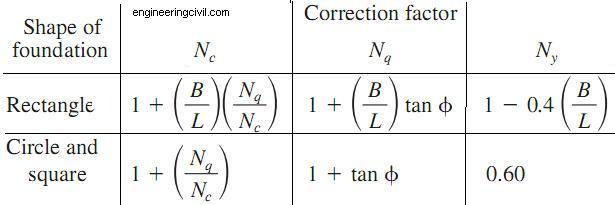The maximum load that can be sustained by shallow foundation elements due to the bearing capacity is a function of the cohesion and friction angle of bearing soils as well as the width B and shape of the foundation. The net bearing capacity per unit area, qu, of a long footing is expressed as:

where
(alpha)f= 1.0 for strip footings and 1.3 for circular and square footings
cu= Un-drained shear strength of soil
(sigma) vo = effective vertical shear stress in soil at level of bottom of footing
(beta)f = 0.5 for strip footings, 0.4 for square footings, and 0.6 for circular footings
gamma =unit weight of soil
B=width of footing for square and rectangular footings and radius of footing for circular footings
Nc, Nq, N=bearing-capacity factors, functions of angle of internal friction (phi)
For undrained (rapid) loading of cohesive soils, phi=0
thus equation reduced to
qu= N ‘c cu
where
N’c=(alpha)fNc
Assumptions made
1) The equation is based on an infinitely long strip footing.
2) The soils to be homogeneous throughout the stressed zone.
The value of correction factors can be had from the table below

Eccentric loading
The bearing value for foundation design is impacted by the Eccentric loading. We assume the footing to be rigid and the bearing pressure vary linearly .
Points to ponder
For the case where only a portion of the footing is bearing, the maximum pressure may be approximated by trial and error.
For all cases of sustained eccentric loading, the maximum (edge) pressures should not exceed the shear strength of the soil and also the factor of safety should be at least 1.5 (preferably 2.0) against overturning.
If you have a query, you can ask a question here.



i want water resources engineering topices urjent. iam preparing
from IAS intervice.
Requested to send a formilas for calculating stability of R.C.C. foundation which carries 40 ton hopperload and iron ore screen movment
i want basic civil engg topics